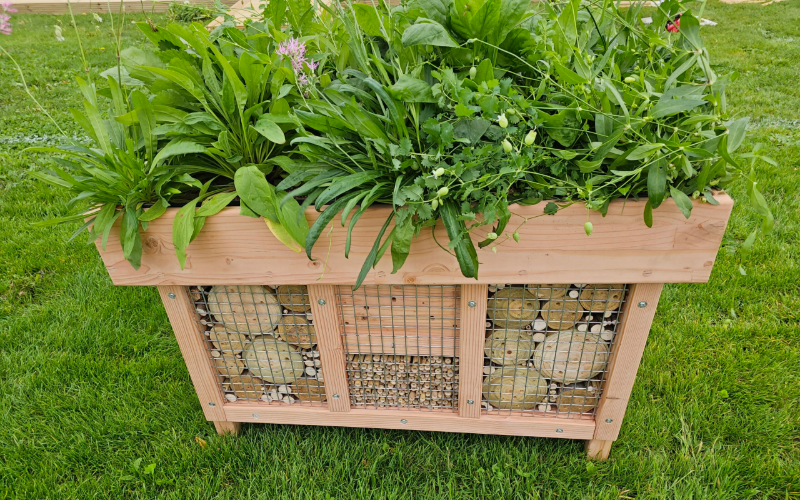
Harrowden Turf shares Biodiversity Net Gain solution
Accredited Supplier, Harrowden Turf discusses bug houses: an innovative solution for biodiversity net gain in commercial settings.
In an era where environmental conservation and sustainability are at the forefront of global discussions, the concept of Biodiversity Net Gain (BNG) has gained significant traction. BNG focuses on enhancing and preserving biodiversity within and around development projects. One innovative and practical approach to achieving BNG is the incorporation of bug houses on commercial sites.
Bug houses, also known as insect hotels or habitats, serve as valuable sanctuaries for a myriad of beneficial insects.
The Importance of Biodiversity:
Before delving into the advantages of bug houses, it is crucial to understand the significance of biodiversity. Biodiversity refers to the variety of life on Earth, encompassing the diversity of species, ecosystems, and genetic diversity within species. A rich and diverse ecosystem provides numerous benefits, including improved ecosystem resilience, pollination of crops, pest control, and overall environmental stability. Commercial sites, often associated with urban development, can inadvertently contribute to the decline of biodiversity. Bug houses emerge as a practical solution to counteract this trend and actively promote biodiversity within these settings.
Bug Houses as Biodiversity Hubs:
Bug houses act as miniature ecosystems, providing a safe haven for a wide array of insects. In a commercial setting where green spaces may be limited, bug houses serve as compact biodiversity hubs. These structures are typically constructed using a variety of materials, like wood, bamboo, and straw, creating diverse habitats suitable for different insect species. Holes and gaps in bug houses mimic the natural nesting sites for solitary bees and other pollinators, encouraging them to move in.
Supporting Pollinators:
One of the most crucial roles bug houses play in enhancing biodiversity is providing a habitat for pollinators. Bees, butterflies, and other pollinating insects are essential for the reproduction of many plants, including numerous crops that contribute to human sustenance. The decline in pollinator populations poses a serious threat to global food security. Bug houses can help reverse this trend by offering nesting sites for solitary bees and attracting butterflies, ensuring the continued pollination of plants in the surrounding area.
Natural Pest Control:
In commercial settings, pest control is a constant concern. Rather than relying solely on chemical pesticides, bug houses offer a natural and sustainable alternative. Predatory insects, like ladybirds, lacewings, and predatory beetles, find refuge in bug houses. These natural predators feed on common garden pests, helping to maintain a balance in the ecosystem without the need for harmful chemicals. By introducing bug houses, commercial sites can foster a healthy ecosystem that regulates pest populations in an environmentally friendly manner.
Educational Opportunities:
Beyond their ecological benefits, bug houses present unique educational opportunities. Commercial sites can use these structures as focal points for educational programmes, raising awareness about the importance of biodiversity and the role of insects in the ecosystem. Incorporating bug houses into corporate sustainability initiatives can engage employees and stakeholders in hands-on conservation efforts, fostering a sense of environmental responsibility within the community.
Enhancing Aesthetic Appeal:
Bug houses, when strategically placed, can enhance the aesthetic appeal of commercial sites. Rather than viewing them as utilitarian structures, bug houses can be designed to complement the overall landscaping, adding a touch of natural beauty to the surroundings. Incorporating artistry and creativity into bug house design not only makes them visually appealing but also encourages public interest and appreciation for the importance of biodiversity.
Mitigating Urban Heat Islands:
Urban heat islands, caused by the excessive heat retention of urban surfaces, are a common challenge in commercial areas. Bug houses can play a role in mitigating this issue by contributing to green spaces and promoting overall environmental cooling. The vegetation surrounding bug houses helps create microclimates that counteract the heat island effect, providing a more comfortable environment for both humans and wildlife.
Compliance with Biodiversity Net Gain Requirements:
As the importance of biodiversity gains recognition worldwide, the UK is implementing policies and standards that mandate Biodiversity Net Gain for development projects. Bug houses offer a practical and measurable means for commercial sites to achieve and exceed these requirements. By actively promoting the establishment of bug habitats, businesses can demonstrate their commitment to environmental stewardship and contribute positively to BNG metrics.
So, the adoption of bug houses represents a forward-thinking and ecologically responsible approach to urban development. These structures not only contribute to the enhancement of biodiversity but also offer a range of additional benefits, from natural pest control to educational opportunities. As the global community grapples with the challenges of sustainable development, bug houses emerge as small but important tools that businesses can employ to achieve BNG targets.
By investing in bug houses, commercial sites can serve as beacons of environmental responsibility, contributing to a healthier planet for generations to come.
